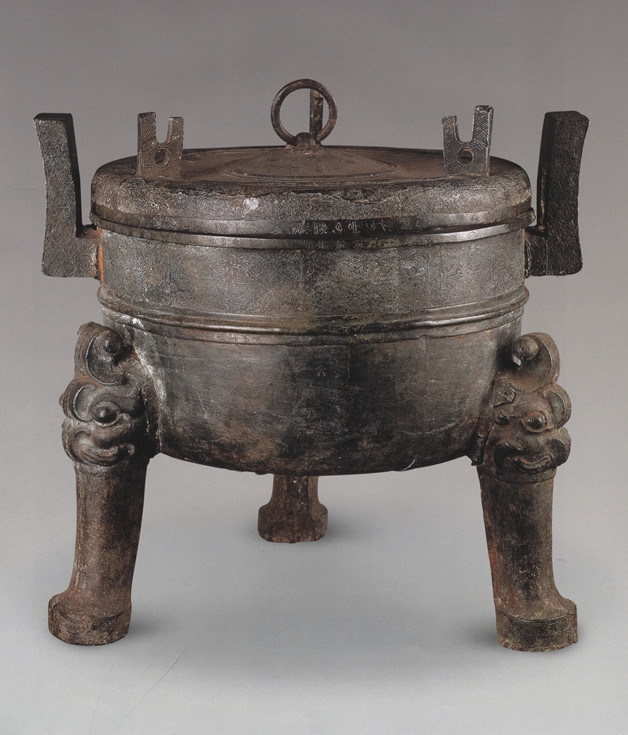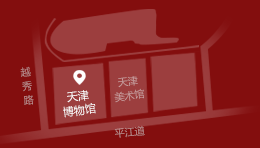战国 楚王酓(悍)鼎
战国(公元前475—公元前221年)
通高53厘米 口径45.5厘米 腹围148厘米
鼎,是殷周青铜器中数量最多、地位最重要的器类,它既是炊器、盛食器,也是贵族进行宴飨、祭祀等礼制活动时最重要的礼器之一。此外,如人们耳熟能详的《左传》宣公三年记楚庄王问鼎中原的故事,表明鼎也被作为王权的象征。
天津博物馆馆藏战国楚王鼎通高53厘米,口径45.5厘米,腹围148厘米。该鼎附耳,直腹,兽蹄形足,并附盖,盖上有环和三个变形的鸟状钮,共有铭文六十字,分布在鼎盖内、口沿、腹部等处。铭文记载了楚幽王为庆贺胜利用缴获的兵器铸成此鼎的经过并用于祭祀的史实。楚幽王,熊(写作酓)姓,名悍(即忎),公元前237—228年在位。
楚人是华夏族南迁的一支,兴起于荆楚(今湖北)大地的楚部落,楚国是春秋战国时期南方的诸侯国,其国君为熊氏。楚国都邑曾几经迁徙,公元前241年,楚王考烈为避秦国威胁,将都城迁至寿春(今安徽寿县),经历考烈、幽、哀、负四王,于公元前223年被秦将王翦所破,楚亡。
楚王鼎出土于安徽寿县朱家集(今属长丰县)李三孤堆。李三孤堆是传说中的楚王陵所在。1933年,安徽大水,李三孤堆坟茔被打开,有人说是被大水冲开,也有的说是被当地的保甲带人挖开,出土文物中以青铜礼器居多。寿县铜器,是楚国器物的第一次大规模出土,震撼了中国文化界,同时也使各地文物商贩云集,地方官绅强取豪夺。当时的政府闻讯将缴获的七百余件文物封存于县教育局,后移交省图书馆,解放后入藏安徽省博物馆。另有一些文物流散各地,其中楚王鼎、豆、簋、勺、簠等十件铜器流至天津宝楚斋李氏,后入藏天津博物馆。今日观众看到的楚王鼎就是这批楚器中形体较大、铭文较多的一件重要文物,被誉为“南北楚器之冠”。同一形制、相同大小、铭文一样的楚王鼎同时铸造了两件,另一件保存在国家博物馆。
Ding of King Yin han of Chu
Warring States period(475-221 BC)
Height overall 53 cm, Diameter of mouth 45.5 cm, Circumference of body 148 cm
This ding has handles attached to it, a straight-sided body, and hoof-shaped feet. Its lid features a ring and three contorted, bird-shaped knobs. There are 60 characters inscribed on the vessel, in places such as the inside of the lid, around the rim of the mouth and on the belly. They record that King Xionghan of Chuyou(r. 237-228 BC) had this ding cast in celebration of his victories from weapons taken as the spoils of war, and that it was used in sacrificial rituals. The assertive and sturdy modeling of this ding imbues it with an air of grandeur. It is a valuable example of excavated Chu wares. Famous as being foremost among Northern and Southern Chu wares. Numerous other Chu wares were excavated alongside it. Ten of these objects, including the Chu king’s ding, dous and fu(food vessel), yi(water vessel) and shaos (ladies) were first in the Chu Store of Tianjin Treasures of the Li clan, later entering the collection of the Tianjin Museum.





 电话:022-83883000
电话:022-83883000 传真:022-83883088
传真:022-83883088 地址:天津市河西区平江道62号
地址:天津市河西区平江道62号